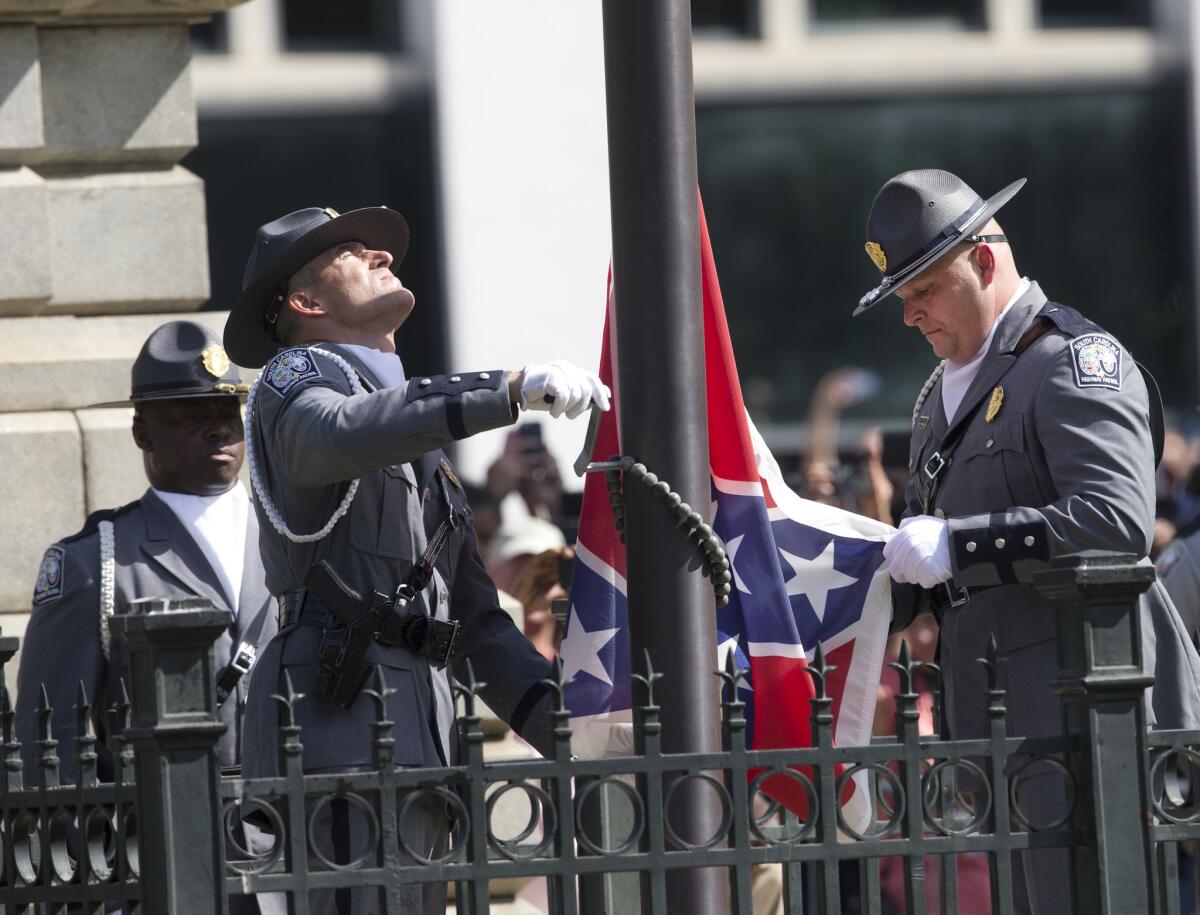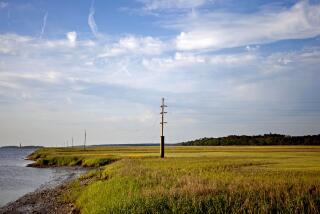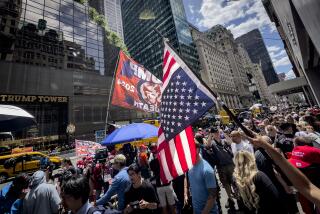South Carolina Confederate flag heads to museum after crowd cheers its removal

An honor guard from the South Carolina Highway Patrol removes the Confederate battle flag from the Capitol grounds.
In the predawn hours Friday, Brenda Bowden, a retired middle school teacher, packed up her sun hat, digital camera and cooler and left her suburban golf community in Fort Mill, S.C., for the state capital.
During the long drive, she thought of her ancestors who were slaves during the Civil War and poor sharecroppers during the Jim Crow era. She remembered attending a newly integrated middle school and how teachers turned their backs to her.
“When I think back on all the hardships that my family had to endure, I am very proud to arrive at this moment,” Bowden said as she sat back in a lawn chair on Statehouse grounds and stared up at a Confederate flag fluttering in the thick July air.
“That flag,” she said, “has always been a symbol of hate.”
Bowden was one of thousands of South Carolinians — black and white — who gathered early Friday to watch the Confederate battle flag finally be removed from its 54-year home at the Capitol.
Some held up the U.S. flag; others the South Carolina state banner. A few lone protesters waved Confederate symbols. Across the street, office workers peered down from glassy high-rises, capturing the event on their cellphones.
The Confederate flag — and the legacy of the Civil War — has long been a contentious issue in this state, the first to secede from the union. To this day, its Capitol building bears brass bolts in the form of Confederate stars in its granite walls to mark the damage inflicted by Gen. William Tecumseh Sherman’s cannon fire during the Civil War.
Yet after the June 17 massacre of nine black churchgoers, including state Sen. Clementa Pinckney, at Emanuel African Methodist Episcopal Church in Charleston, the momentum to take down the flag could not be stopped. Dylann Roof, 21, who has been charged with nine counts of murder in the shooting, had been photographed with the flag and other Confederate symbols, and police said he espoused racist ideologies.
Most of those gathered outside the Capitol building viewed the Confederate flag as an emblem of a time when African Americans were chained, whipped and traded as chattel.
“When the Klan tortured my great-great-grandfather, they wrapped him up in that flag and lay him on a railroad track and waited for a freight train to run over him,” said Phyllis Lloyd Harris, 61, a retired special education teacher from Camden, S.C. “That’s my heritage. To see this flag come down closes that era for me.”
The Confederate flag has flown on South Carolina’s statehouse grounds since 1961, when it was put atop the Capitol dome to celebrate the 100th anniversary of the Civil War. In 1962, legislators voted for the banner to remain up in a gesture of defiance against the civil rights movement. In 2000, after years of protest from civil rights leaders, the flag was removed from the dome and a smaller one was placed next to a Civil War memorial on the front lawn.
In 2000, thousands had also gathered at the Capitol when the banner was moved. Back then, flag supporters chanted, “Off the dome and in your face!” Opponents held signs that read “Shame.”
The mood could not have been more different Friday as a legislators and city officials lined up underneath the Capitol’s Corinthian columns.
Almost everyone erupted in cheers when Republican Gov. Nikki Haley, one of the first officials to call for the flag to be taken down in the wake of the Emanuel shootings, walked out onto the front steps. A voice from behind the metal barricades yelled, “Take it down,” and the chant spread.
Seven Highway Patrol honor guards marched in formation across the Capitol lawn. When a white trooper turned the handle affixed to the 30-foot flagpole, the crowd roared.
The Confederate cloth was lowered.
“Na-na-na-na, hey hey hey, goodbye,” the crowd sang as two officers neatly rolled the banner. The flag was handed to the guard’s leader, Lt. Derrick Gamble, a black trooper who led the contingent across the lawn and presented the flag to Allen Roberson, director of the Confederate Relic Room and Military Museum.
The crowd burst into chants of “USA, USA, USA.”
“For years, I have waited for this moment,” said Tameka Wood, 37, a black high school English teacher who stood under the shade of a magnolia tree in a long dress emblazoned in stars and stripes.
“South Carolina was the first state to secede from the Union, and now it’s time to come back into the fold,” said Wood, who lives in Baltimore but attended college in Columbia. “We are one America.”
Minutes after the flag came down, demonstrators held up a whole new array of handwritten messages on pieces of cards and paper: “Victory. It’s gone,” “United we stand as one” and “We did it. Si se puede.”
Yet not everyone was jubilant.
“This is a very sad moment,” said Michael Lewis, 46, a protester who had driven there from Southside, Va. For Lewis, who has an ancestor who fought in the Virginia Cavalry, the flag honors the soldiers who died fighting for the Confederacy.
“This flag is so much more than a symbol of hate,” Lewis said. “We’re losing an ability to educate people about the flag and what it really represents. Hiding it and tucking it away is not going to stop all the social dysfunction.”
Yet amid all the diverse perspectives on the flag, and its meaning, there was one source of agreement: Those assembled were witnesses to a moment of history.
The flag was taken in an armored vehicle to the museum and put in a storeroom for safekeeping. Eventually, it will be put on display among a collection that includes Confederate and Union weapons, ammunition, uniforms, private letters from a 3rd South Carolina Volunteer Infantry lieutenant to his father, excavated relics from Sherman’s attack and a diorama depicting Columbia in flames.
Only a cluster of onlookers remained later, when a crane finally yanked the flagpole from the lawn. Finally, the flagpole was loaded on a flatbed truck and hauled away.
Gamble, the black trooper, said he was overwhelmed by the chain of events in his state — he had been among those who carried Pinckney’s casket up to the Statehouse.
“Something very special has been happening in South Carolina over the last few weeks — maybe not what we expected,” said Gamble, 47. “I’m just honored to be a part of this historical moment — taking a tragic situation and bringing everyone together.”
Jarvie is a special correspondent.
More to Read
Sign up for Essential California
The most important California stories and recommendations in your inbox every morning.
You may occasionally receive promotional content from the Los Angeles Times.











